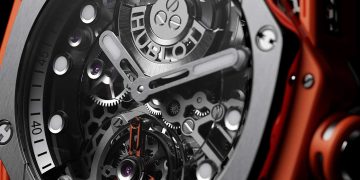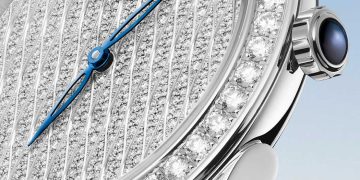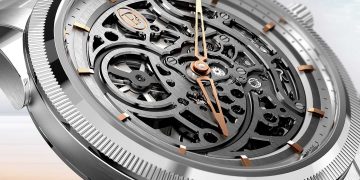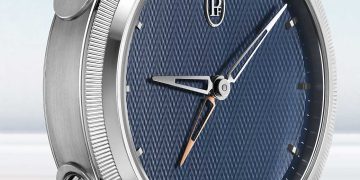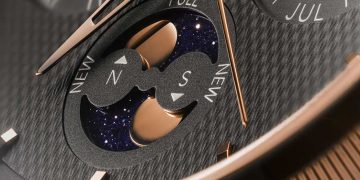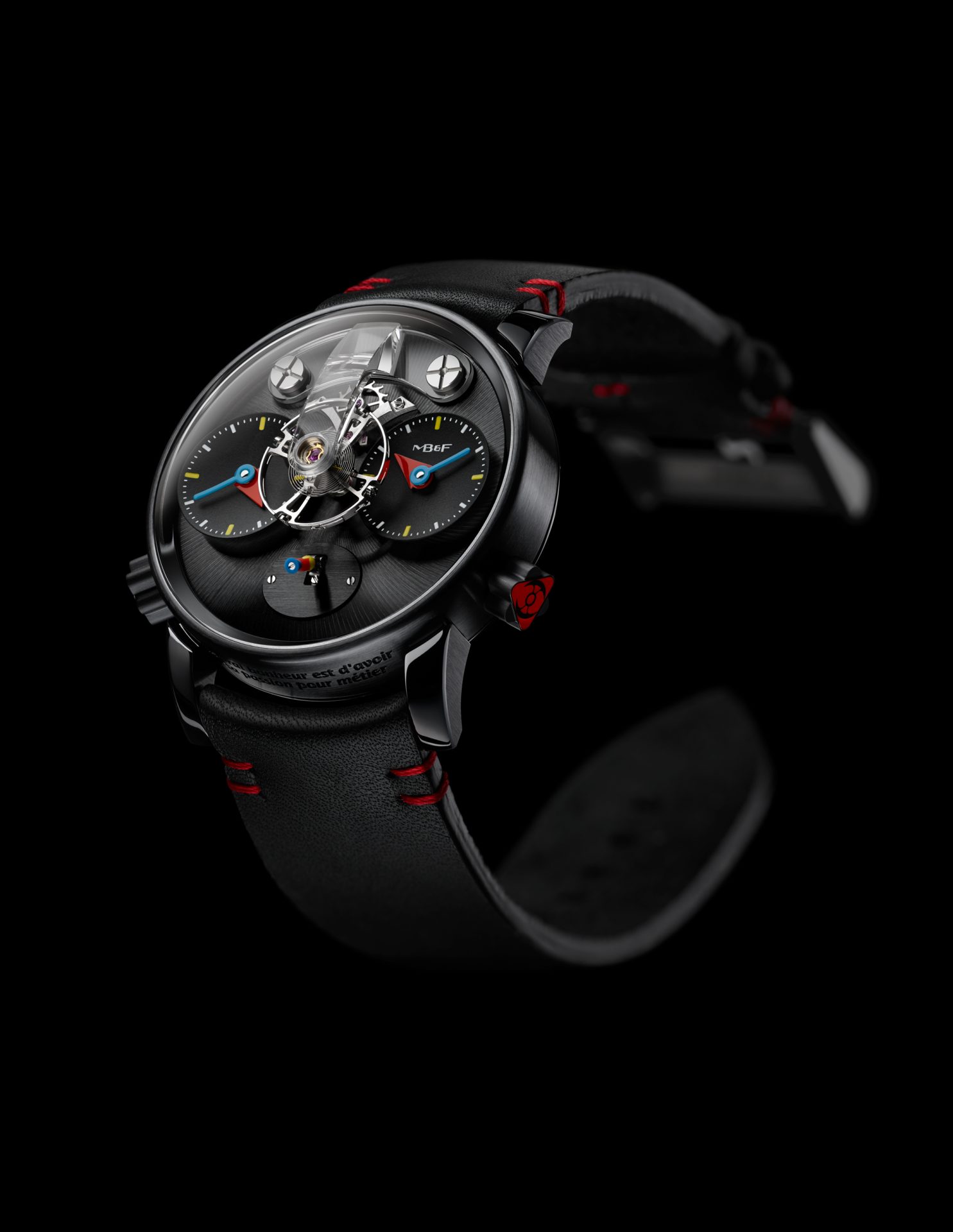
Engraved in French on the case band between the lugs of LM1 Silberstein is a paraphrased quote from Gustave Flaubert: “Le vrai bonheur est d’avoir sa passion pour métier” – which translates roughly as, “Making a profession of your passion is true happiness”.
The phrase carries special meaning for both French watch designer Alain Silberstein, who left the safety of working in his trained profession as an interior designer to found his own watch brand, and MB&F founder Maximilian Büsser, who left the security of being a successful CEO of a well-known brand to found his own niche creative lab.
In 2009, MB&F had called on Silberstein to create its very first piece of ‘Performance Art’ – reinterpretations by external artists and designers of existing MB&F Machines. The result was the HM2.2 ‘Black Box’, followed by a long list of collaborations with other creators. For this new Performance Art series, Silberstein has taken MB&F’s classic Legacy Machine N°1 and imbued it with his unique flair for the unconventional. His use of his signature three bright colours and shapes: red, blue and yellow; triangle, rectangle and circle for the hands and dial markers; and three-dimensionally translated as a cone, cube and sphere for the power reserve, catch the eye as they contrast against the more subdued movement plate below.
However, it is the concave curve of the subdials that highlights the artist’s philosophical approach most. While the convex sapphire crystal dome and balance bridge offer protection from outside forces, the concave subdials attract and welcome the “eternal time” of the universe into the movement, where it is transformed and displayed as two completely independent time zones. Naturally, the hands are similarly concave so that they seamlessly complement the curvature of the dials.
“I resonated with LM1 because by highlighting the balance – the mechanism that splits time into miniscule increments – it highlights how man converts eternal time into something he can use”, Silberstein explains.
Silberstein felt strongly that, as the balance is the “beating heart” of the timepiece, nothing should break the view of the dial side regulator or block “eternal time” from reaching the time indications. He also thought that as graceful as the dual arcing bridges of the original LM1 were, they took too much visual attention from the indications. Two years of development were required to create the transparent sapphire crystal balance bridge to the incredibly tight tolerances required to support the balance wheel. And all of that work for an elegantly shaped component that is essentially designed to be invisible.
“It was a pleasure to work from such a creative timepiece as LM1 because the suspended balance and arched bridge made it feel like working on the set of a science fiction film”.
Even the two crowns are steeped in Silberstein magic: their distinctive six-pointed star shapes formed by overlapping two triangles make winding a tactile pleasure.
LM1 Silberstein is a limited edition of 3 x 12 pieces in red gold, titanium, or black PVD-treated titanium.
LM1 Silberstein in detail
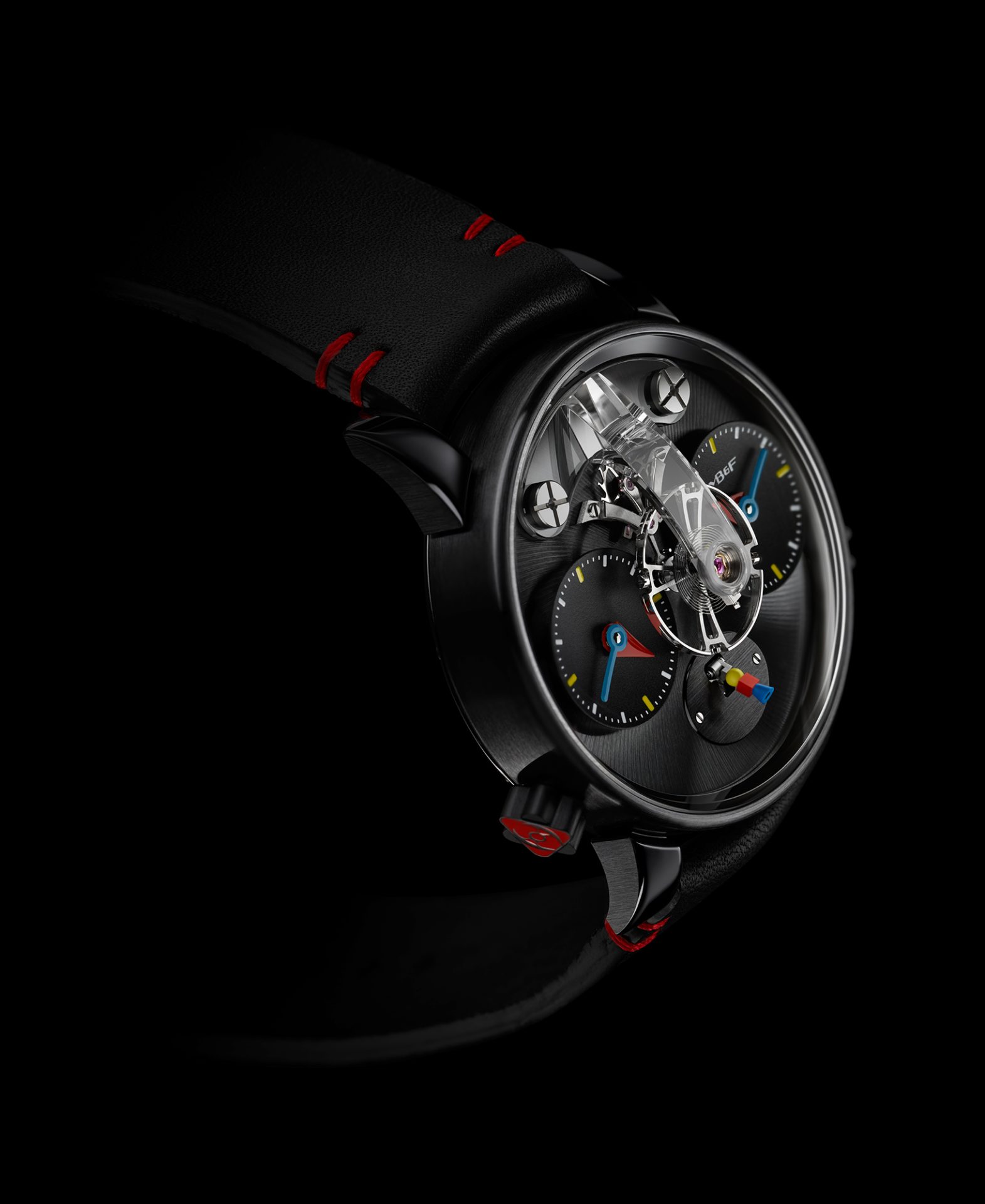
Inspiration and realization: Alain Silberstein had one overriding aim in his vision of creating a ‘Performance Art’ edition of LM1: to welcome the “eternal time” of the universe into the movement, where it would be transformed into time on a more human scale. To realise this, he envisaged concave subdials to catch “eternal time”, rather than the convex subdials of the original LM1. He also envisaged replacing the original dual arches of LM1’s balance bridge with a single, transparent bridge, allowing full visual access to the time indications and dial-side escapement.
The colours and shapes of the concave hands highlight Silberstein’s meticulously practical approach to artistic design. When reading the time, the hour is generally the first bit of information required. So the hour hands are a brighter colour (red) on a larger surface area (triangle) than the thinner blue minute hands.
The three primary colours found on the subdials – red and blue hands, yellow index markers – are echoed in the three shapes – blue cone, red cube, and yellow sphere – of the three-dimensional power reserve indicator.
The six-pointed crowns (comprising two overlapping triangles) also reinforce the collaborative aspect of this Performance Art piece: the shapes and colours of the crown are pure Silberstein, while the battle-axe logo represents MB&F.
Silberstein uses contrast and materials to surreptitiously guide the eye to key elements on the dial: the hands are both brightly coloured and high gloss, while the underlying dials and movement plates feature more subdued colours with matte finishes.
“I like playing with materials and finishes. The more matte there is, the more the high polish pops”.
Engine: LM1’s ingenious three-dimensional movement was specifically developed for MB&F from Maximilian Büsser’s sketches by Jean-François Mojon and his team at Chronode together with independent watchmaker Kari Voutilainen. The balance wheel and spring at the very heart of any mechanical watch movement are responsible for regulating timekeeping accuracy. Büsser has long been fascinated by the large slowly oscillating balance wheels of antique pocket watches –18,000 bph compared with the 28,800 bph common today – so it was no surprise this was the starting point from which to let his fertile imagination roam free. What was surprising, though, is just how radically he re-interpreted tradition by relocating the balance wheel from its more usual position hidden at the back of the movement to not just the top of the movement, but floating above the dials!
While the location of Legacy Machine N°1’s regulating organ may be considered avant-garde, ‘tradition’ is upheld by the large 14mm diameter balance wheel with regulating screws specifically developed for MB&F, balance spring with Breguet overcoil, and mobile stud holder.
Another very special feature of the LM1 movement is the ability to set the two time zones completely independently. The vast majority of dual time zone movements only allow the hours to be independently adjusted, a rare few offer setting to the half hour. Legacy Machine N°1 allows both hours and minutes of each dial to be set to whatever time the user wishes.
The world’s first vertical power reserve indicator on LM1 is driven by an ultra-flat differential with ceramic bearings allowing for a slimmer complication and a more robust and longer-wearing mechanism.
Dial and indications: The rate keeping of the twin dials is controlled by the same regulator (balance and escapement) so that once set, the two times stay perfectly synchronised with each other. Both the hours AND minutes on both dials can be set to any time desired via their respective crowns.
Complementing the three-dimensionality of the balance floating in space, the dual concave dials with their brightly coloured hands float above the top of the movement. To ensure aesthetic purity of the dials, a sophisticated fixation system underneath negates the necessity of visually obtrusive screws.
Fine finishing and historical legitimacy: Acclaimed master watchmaker Kari Voutilainen assumed responsibility for ensuring the historical accuracy of the style and finishing of the Legacy Machine N°1 movement. No easy task with such an unconventional suspended-balance design from which to begin.
It is in the style and finish of the bridges and plates visible through the sapphire crystal window on the back of the movement where Kari Voutilainen has excelled in providing exquisite historical fidelity; both in the shape of the elegantly curved bridges, and the traditionally wide space between the bridges and between the perimeter of the bridges and the case.
On the back of the movement, oversized ruby jewels set in highly-polished countersunk gold chatons provide striking visual counterpoints to the frosted, sensually curved bridges. While providing historical links with the large jewels seen in high-grade antique pocket watch movements, the ruby bearings have a practical application in reducing wear and increasing longevity by accommodating large diameter pinions and holding more lubricating oil.
LM1 Silberstein – Technical Specifications
Limited editions of 3 x 12 pieces in red gold, titanium, or black PVD-treated titanium.

Engine:
Three-dimensional horological movement developed exclusively for MB&F by Jean-François Mojon/Chronode and Kari Voutilainen
Manual winding with single mainspring barrel
Power reserve: 45 hours
Balance bridge: transparent sapphire crystal
Balance wheel: bespoke 14mm balance wheel with four traditional regulating screws floating above the movement and dials
Balance spring: traditional Breguet overcoil terminating in mobile stud holder
Balance frequency: 18,000bph/2.5Hz
Number of components: 279
Number of jewels: 23
Chatons: gold chatons with polished countersinks
Fine finishing: superlative hand finishing throughout respecting 19th-century style; internal bevel angles highlighting hand craft; polished bevels; hand-made engravings; frosted finish
Functions:
Hours and minutes; completely independent dual time zones displayed on two dials; unique vertical power reserve indicator
Crown at 8 o’clock for setting time of left dial; crown at 4 o’clock for setting time of right dial and winding
Case:
Available in 18k red gold, grade 5 titanium or grade 5 titanium treated with black PVD
Dimensions: 42.5mm wide x 17mm high
Number of components: 41
Water resistance: 30m / 3atm / 90’
Sapphire crystals:
High domed sapphire crystal on top and sapphire crystal on back with anti-reflective coating on both sides; balance wheel bridge in sapphire crystal.
Strap & Buckle:
Black hand-stitched calfskin strap with black topstitched seams with red gold case, or red topstitched seams with both titanium cases.
‘Friends’ responsible for LM1 Silberstein
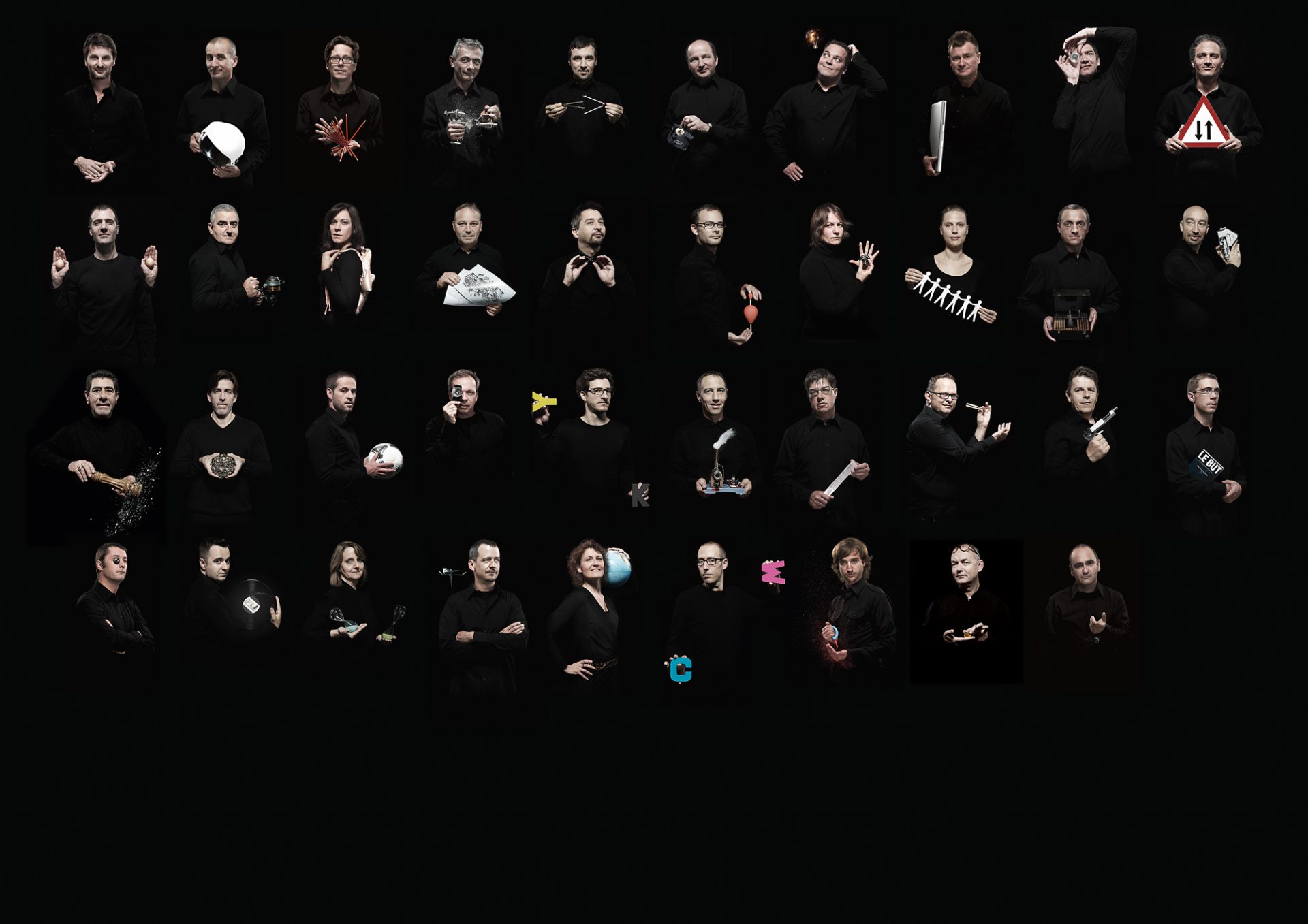
Concept: Maximilian Büsser / MB&F
Product design: Eric Giroud / Eric Giroud Design Studio
Performance artist: Alain Silberstein
Technical and production management: Serge Kriknoff / MB&F
Movement development: Jean-François Mojon / Chronode
Movement design and finish specifications: Kari Voutilainen / Voutilainen Horlogerie d’Art
R&D: Guillaume Thévenin and Ruben Martinez / MB&F
Wheels: Dominique Guye / DMP Horlogerie SA
Balance wheel: Dominique Lauper / Precision Engineering
Plates and bridges: Rodrigue Baume / Damatec
Small components: Yves Bandi / Bandi and Jean-François Mojon / Chronode
Hand-engraving of movement: Sylvain Bettex / Glypto
Hand-finishing of movement components: José Labarga / Labarga, Jacques-Adrien Rochat and Denis Garcia / C-L Rochat
Movement assemblage: Didier Dumas, Georges Veisy, Anne Guiter and Emmanuel Maitre/ MB&F
In-house machining: Alain Lemarchand / MB&F
Quality Control: Cyril Fallet / MB&F
Case: Pascal Queloz / Oréade
Buckle: Erbas S.A.
Dials: Maurizio Cervellieri / Natéber
Hands: Waeber HMS
Glass: Martin Stettler / Stettler
Strap: Tristan Guyotjeannin / Creations Perrin
Presentation box: Olivier Berthon / ATS Atelier Luxe
Production logistics: David Lamy and Isabel Ortega / MB&F
Marketing & Communication: Charris Yadigaroglou, Virginie Meylan and Juliette Duru / MB&F
M.A.D.Gallery: Hervé Estienne / MB&F
Sales: Patricia Duvillard and Philip Ogle / MB&F
Graphic design: Samuel Pasquier / MB&F, Adrien Schulz and Gilles Bondallaz / Z+Z
Product photography: Maarten van der Ende
Portrait photography: Régis Golay / Federal
Website: Stéphane Balet / Nord Magnétique et Victor Rodriguez / Nimeo
Texts: Ian Skellern / Underthedial
Alain Silberstein biography: metres to microns
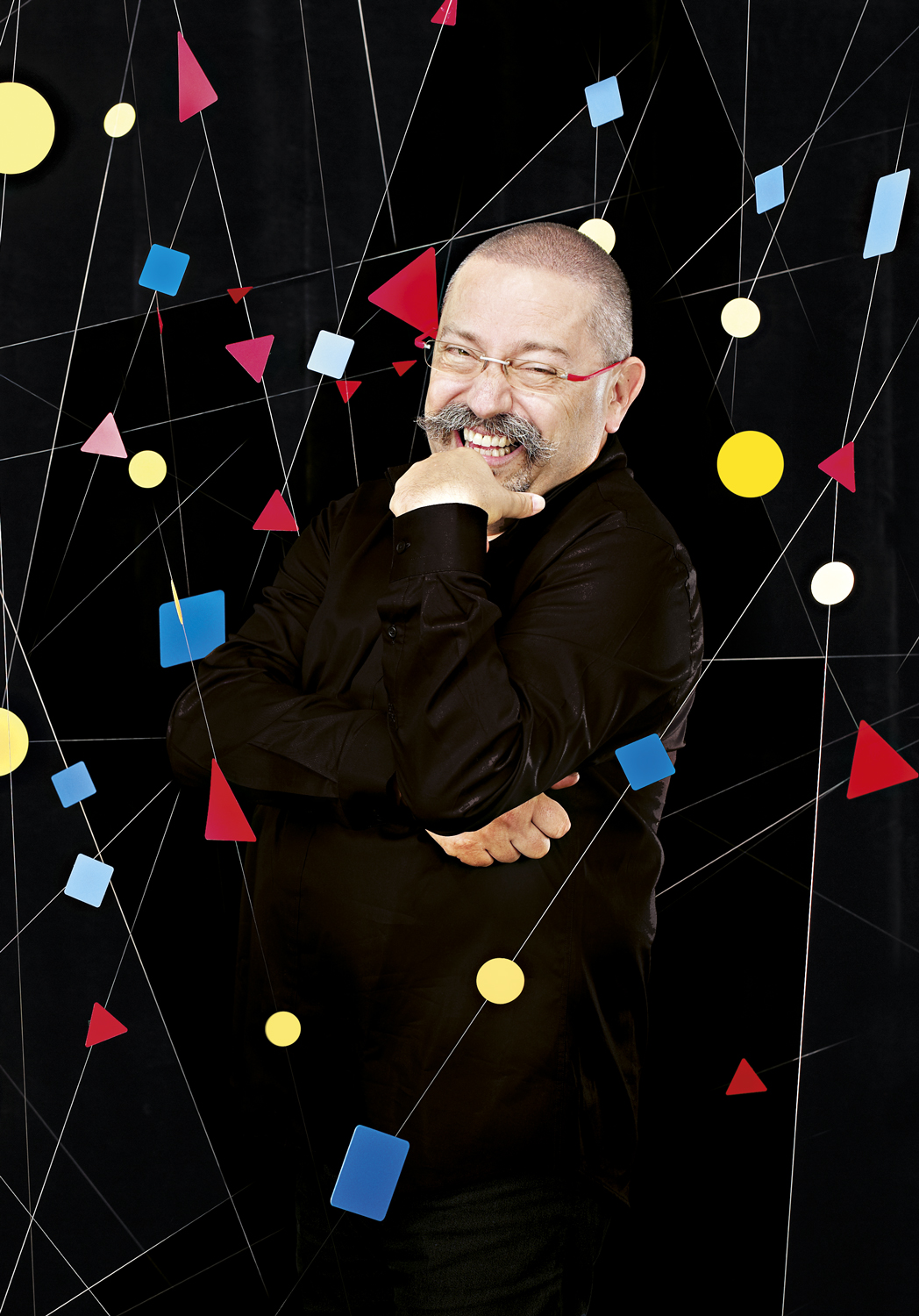
Alain Silberstein was born in 1950 in Paris, France. After graduating with a diploma in interior architecture and model making, he worked first as an interior designer in Paris, then continued in that field after moving to Besançon in 1979 − the centre of France’s watchmaking industry. Silberstein fell in love with watchmaking and in 1990 founded his own brand, Alain Silberstein Créations, which ceased operations in 2012.
While interior design and designing watches share quite a few commonalities including the harmonious juxtaposition of colours and textures, the scale is quite different: Silberstein replaced working in metres with working in microns.
“In all my creations I search for the radical, which is finding the very essence of what should be highlighted”.
Silberstein’s watches are known for the signature use of three bright primary colours (red, blue, and yellow); three simple geometric shapes (triangle, square/rectangle, and circle or in three dimensions pyramid, cube, and sphere); and sophisticated juxtaposition of materials and finishes.
Silberstein was the first to create a watch with a sapphire crystal case, and he was a pioneer in making haute horlogerie playful with his use of bright colours and non-traditional materials.
“Colour is important, but you have to always keep in mind that you cannot disassociate colour from the material. Finishes can also convey a sense of colour”.
Silberstein now works as an independent watch designer. He is a long time Friend of MB&F, having first collaborated on the Bauhaus-inspired HM2.2 Black Box Performance Art piece in 2009.
MB&F – Genesis of a Concept Laboratory
In 2015, MB&F celebrated its 10th anniversary – and what a decade it has been for the world’s first ever horological concept laboratory: 10 years of hyper-creativity; 11 remarkable calibres forming the base of the critically acclaimed Horological Machines and Legacy Machines for which MB&F has become renowned.
After 15 years managing prestigious watch brands, Maximilian Büsser resigned from his Managing Director position at Harry Winston in 2005 to create MB&F – Maximilian Büsser & Friends. MB&F is an artistic and micro-engineering laboratory dedicated to designing and crafting small series of radical concept watches by bringing together talented horological professionals that Büsser both respects and enjoys working with.

In 2007, MB&F unveiled its first Horological Machine, HM1. HM1’s sculptured, three-dimensional case and beautifully finished engine (movement) set the standard for the idiosyncratic Horological Machines that have followed: HM2, HM3, HM4, HM5, HM6 and HMX – all Machines that tell the time, rather than Machines to tell the time.
In 2011, MB&F launched its round-cased Legacy Machine collection. These more classical pieces – classical for MB&F, that is – pay tribute to nineteenth-century watchmaking excellence by reinterpreting complications from the great horological innovators of yesteryear to create contemporary objets d’art. LM1 and LM2 were followed by LM101, the first MB&F Machine to feature a movement developed entirely in-house. The year 2015 saw the launch of Legacy Machine Perpetual featuring a fully integrated perpetual calendar. MB&F generally alternates between launching contemporary, resolutely unconventional Horological Machines and historically inspired Legacy Machines.
As well as Horological and Legacy Machines, MB&F has created space age Music Machines (1, 2 and 3) in collaboration with Reuge; unusual clocks in the form of a space station (Starfleet Machine) and a spider (Arachnophobia); as well as two robot clocks (Melchior and Sherman).
And there have been distinguished accolades reminding us of the innovative nature of MB&F’s journey so far. To name a few, at the Grand Prix d’Horlogerie de Genève in 2012, MB&F was awarded the Public Prize (voted for by horology fans) and the Best Men’s Watch Prize (voted for by the professional jury) for Legacy Machine No.1. At the 2010 Grand Prix d’Horlogerie de Genève, MB&F won Best Concept and Design Watch for the HM4 Thunderbolt. In 2015 MB&F received a Red Dot: Best of the Best award – the top prize at the international Red Dot Awards – for the HM6 Space Pirate.

